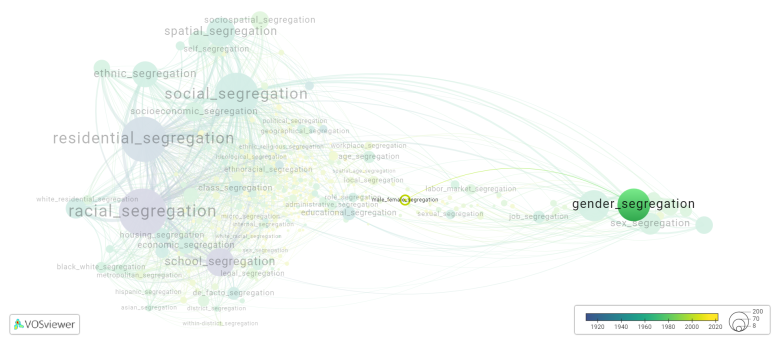Male female segregation: Difference between revisions
(Creating page) |
(Creating page) |
||
| (9 intermediate revisions by the same user not shown) | |||
| Line 1: | Line 1: | ||
===== Date and country of first publication<ref>Date and country of first publication as informed by the Scopus database (December 2023).</ref>===== | |||
2011<br> | 2011<br> | ||
United | United States | ||
===== Definition ===== | |||
Male female segregation refers to the separation of men and women in various aspects of society, such as in education, the workforce, or social activities. This can take the form of gender-specific schools or classes, gender-segregated workplaces or roles, or gender-specific social spaces or events. | Male female segregation refers to the separation of men and women in various aspects of society, such as in education, the workforce, or social activities. This can take the form of gender-specific schools or classes, gender-segregated workplaces or roles, or gender-specific social spaces or events. | ||
| Line 13: | Line 12: | ||
Efforts to reduce male female segregation may include promoting gender diversity and inclusivity in various settings, challenging stereotypes and biases about men and women, and advocating for policies and practices that support gender equality and integration. | Efforts to reduce male female segregation may include promoting gender diversity and inclusivity in various settings, challenging stereotypes and biases about men and women, and advocating for policies and practices that support gender equality and integration. | ||
==See also== | ==See also== | ||
==Related segregation forms== | |||
Male female segregation is frequently discussed in the literature with the following segregation forms: | |||
[[gender segregation]] | |||
[[File:male_female_segregation.png|780x780px]] | |||
This visualization is based on the study [[Segregation_Wiki:About| The Multidisciplinary Landscape of Segregation Research]]. | |||
For the complete network of interrelated segregation forms, please refer to: | |||
* [https://tinyurl.com/2235lkhw First year of publication] | |||
* [https://tinyurl.com/2d8wg5n3 Louvain clusters] | |||
* [https://tinyurl.com/223udk5r Betweenness centrality] | |||
* [https://tinyurl.com/244d8unz Disciplines in which segregation forms first emerged (Scopus database).] | |||
==References== | ==References== | ||
==Notes== | ==Notes== | ||
<references /> | <references /> | ||
== | {{NoteAI}} | ||
==Male female segregation appears in the following literature== | |||
Johnson B.J. | Johnson B.J., Crum-Cano B.D. (2011). Glass walls in urban planning: An examination of policy type and gender segregation within a profession. ''Review of Public Personnel Administration'', ''31''(4), 386-409. https://doi.org/10.1177/0734371X11408702 | ||
Sikora J. | Sikora J., Pokropek A. (2012). Gender segregation of adolescent science career plans in 50 countries. ''Science Education'', ''96''(2), 234-264. https://doi.org/10.1002/sce.20479 | ||
Latest revision as of 07:17, 16 October 2024
Date and country of first publication[1][edit | edit source]
2011
United States
Definition[edit | edit source]
Male female segregation refers to the separation of men and women in various aspects of society, such as in education, the workforce, or social activities. This can take the form of gender-specific schools or classes, gender-segregated workplaces or roles, or gender-specific social spaces or events.
There are several factors that contribute to male female segregation, including societal norms and expectations about gender roles, stereotypes and biases about the abilities and characteristics of men and women, and historical patterns of discrimination and exclusion. In some cases, male female segregation may be influenced by religious beliefs or cultural traditions that dictate strict gender roles.
While some argue that male female segregation can help maintain traditional gender norms and protect the privacy and comfort of individuals, others believe it can perpetuate inequality and limit opportunities for women to access education, economic advancement, and leadership positions.
Efforts to reduce male female segregation may include promoting gender diversity and inclusivity in various settings, challenging stereotypes and biases about men and women, and advocating for policies and practices that support gender equality and integration.
See also[edit | edit source]
Related segregation forms[edit | edit source]
Male female segregation is frequently discussed in the literature with the following segregation forms:
This visualization is based on the study The Multidisciplinary Landscape of Segregation Research.
For the complete network of interrelated segregation forms, please refer to:
References[edit | edit source]
Notes[edit | edit source]
- ↑ Date and country of first publication as informed by the Scopus database (December 2023).
At its current state, this definition has been generated by a Large Language Model (LLM) so far without review by an independent researcher or a member of the curating team of segregation experts that keep the Segregation Wiki online. While we strive for accuracy, we cannot guarantee its reliability, completeness and timeliness. Please use this content with caution and verify information as needed. Also, feel free to improve on the definition as you see fit, including the use of references and other informational resources. We value your input in enhancing the quality and accuracy of the definitions of segregation forms collectively offered in the Segregation Wiki ©.
Male female segregation appears in the following literature[edit | edit source]
Johnson B.J., Crum-Cano B.D. (2011). Glass walls in urban planning: An examination of policy type and gender segregation within a profession. Review of Public Personnel Administration, 31(4), 386-409. https://doi.org/10.1177/0734371X11408702
Sikora J., Pokropek A. (2012). Gender segregation of adolescent science career plans in 50 countries. Science Education, 96(2), 234-264. https://doi.org/10.1002/sce.20479

